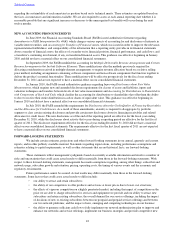Sprint - Nextel 2010 Annual Report Download - page 34
Download and view the complete annual report
Please find page 34 of the 2010 Sprint - Nextel annual report below. You can navigate through the pages in the report by either clicking on the pages listed below, or by using the keyword search tool below to find specific information within the annual report.
Retail Postpaid Subscribers—We lost 855,000 net postpaid subscribers during 2010 as compared to losing 3.5
million and 4.1 million net postpaid subscribers during 2009 and 2008, respectively. Our improvement in net postpaid
subscriber losses year over year can be attributed to our improvements in retail postpaid gross adds and lower postpaid churn
resulting from simplified and value-driven bundled offers, a more competitive device line-up, as well as our continued
improvements in overall customer experience and customer care satisfaction.
Retail Prepaid Subscribers—We added approximately 1.6 million net prepaid subscribers during 2010 as compared
to adding 2.6 million and losing 981,000 net prepaid subscribers in 2009 and 2008, respectively. Our net prepaid subscriber
additions in 2010 were principally driven by net additions from the Assurance Wireless and Boost Mobile brands, partially
offset by net losses associated with the Virgin Mobile brand including a transfer of 49,000 subscribers from prepaid to
wholesale and affiliates as a result of a sale and transfer of customers to an affiliate. Our net prepaid subscriber additions in
2009 as compared to losses in 2008 were principally driven by the Boost Monthly Unlimited plan. Prepaid subscribers are
generally deactivated between 60 days and up to 150 days from the date of activation or replenishment; however, prior to
account deactivation, targeted retention programs can be offered to qualifying subscribers to maintain ongoing service by
providing up to an additional 150 days to make a replenishment. Subscribers targeted through these retention offers are not
included in the calculation of churn until their retention offer expires without a replenishment to their account. As a result, end
of period prepaid subscribers include subscribers engaged in these retention programs. Retention offers to these targeted
subscribers remained consistent as a percentage of our total prepaid subscriber base during 2010.
Wholesale and Affiliate Subscribers—Wholesale and affiliate subscribers represent customers that are served on our
networks through companies that resell our services to their subscribers, customers residing in affiliate territories and a growing
portion of subscribers from our machine-to-machine initiative primarily representing devices that utilize our network. During
2010, wholesale and affiliate subscriber additions were 994,000 resulting in approximately 4.5 million wholesale and affiliate
subscribers as of December 31, 2010, compared to approximately 3.5 million and 9.0 million wholesale and affiliate
subscribers as of December 31, 2009 and 2008, respectively. The increase in the wholesale subscriber base was primarily due to
subscriber additions in other MVNO relationships during 2010. The decrease from 2008 to 2009 was primarily due to
subscribers transferred to postpaid and prepaid as result of the fourth quarter 2009 business combinations of Virgin Mobile and
iPCS. Of the remaining 4.5 million subscribers included in wholesale and affiliate, approximately 41% represent machine-to-
machine activities such as e-readers, in-vehicle devices and telematics. Subscribers through some of our MVNO relationships
have inactivity either in voice usage or primarily as a result of the nature of the device, where activity only occurs when data
retrieval is initiated by the end-user and may occur infrequently. Although we continue to provide these customers access to our
network through our MVNO relationships, approximately 959,000 subscribers through these MVNO relationships have been
inactive for at least six months, with no associated revenue.
Cost of Services
Cost of services consists primarily of:
• costs to operate and maintain our CDMA and iDEN networks, including direct switch and cell site costs, such
as rent, utilities, maintenance, labor costs associated with network employees and spectrum frequency leasing
costs;
• fixed and variable interconnection costs, the fixed component of which consists of monthly flat-rate fees for
facilities leased from local exchange carriers based on the number of cell sites and switches in service in a
particular period and the related equipment installed at each site, and the variable component of which
generally consists of per-minute use fees charged by wireline providers for calls terminating on their networks,
which fluctuate in relation to the level and duration of those terminating calls;
• long distance costs paid to the Wireline segment;
• costs to service and repair devices;
• regulatory fees;
• roaming fees paid to other carriers; and
• fixed and variable costs relating to payments to third parties for the use of their proprietary data applications,
such as messaging, music, TV and navigation services by our subscribers.
Cost of services decreased $96 million, or 1%, in 2010 compared to 2009, primarily reflecting a decline in service
and repair costs by focusing on device repairs and refurbishment rather than utilizing new devices, a decline in long distance
network costs as a result of lower market rates as well as a decline in payments to third party vendors providing premium
services as a result of changing from usage based payments to flat rates. This decline was partially offset by increased roaming
due to higher data usage and an increase in license fees as a result of the continued growth in smartphone devices, which carry
higher fees. Cost of services decreased $361 million, or 4%, in 2009 as compared to 2008 primarily reflecting a decline in
labor, outside services and maintenance costs consistent with the Company's cost cutting efforts, as well as a decline in network
costs associated with fewer subscribers.
Table of Contents
32
























